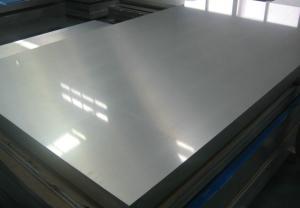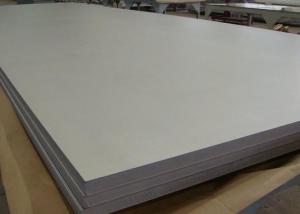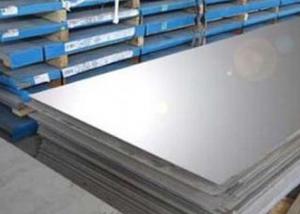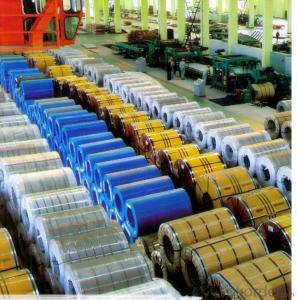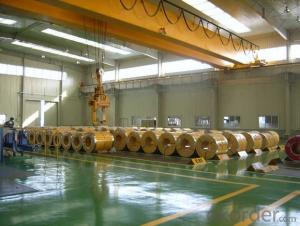304 2B Stainless Steel Sheet
- Loading Port:
- China Main Port
- Payment Terms:
- TT or LC
- Min Order Qty:
- 1 Ton m.t.
- Supply Capability:
- 5000 Tons Per Month m.t./month
OKorder Service Pledge
OKorder Financial Service
You Might Also Like
AISI 304 Stainless steel sheet
1. Chemical composition of AISI 304 Stainless steel sheet
C | Si | Mn | P | S | Ni | Cr |
max0.08 | max1.00 | max2.00 | max0.045 | max0.03 | 8.00-10.50 | 18.00-20.00 |
2. Mechanical properties of AISI 304 Stainless steel sheet
Yield Strength | Tensile | Elongation | Hardness (HV) | Hardness (HRB) |
≥ 205 | ≥ 520 | ≥ 40 | ≤ 200 | ≤ 90 |
3. Standard of AISI 304 Stainless steel sheet : AISI, ASTM, GB, EN, DIN, JIS
4. Surface of AISI 304 Stainless steel sheet : 2B, NO.1, BA, NO.4, Hairline, SB, Mirror finish, Anti-skid, Cherkered etc.
5. Size of AISI 304 Stainless steel sheet :
Thickness: 0.3-3mm (cold rolled), 3-40mm (hot rolled)
Width: 1000mm or 1219mm or 1240mm for cold rolled, 1500mm for hot rolled.
Length: As customers' request.
6. MOQ of AISI 304 Stainless steel sheet : 1 Ton
7. Payment terms of AISI 304 Stainless steel sheet : T/T or L/C
8. Packing of AISI 304 Stainless steel sheet : Seaworthy package with wooden or Iron pallets with the paper and the steel strip,
or as customers' request.
9. Delivery time of AISI 304 Stainless steel sheet : Usually about 7 days after we confirming the order, or according to your quantity.
If you have any demand, pls feel free to contact me.
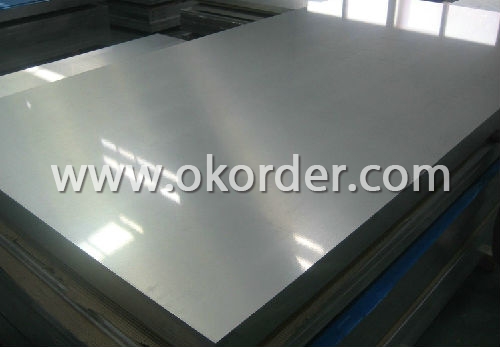
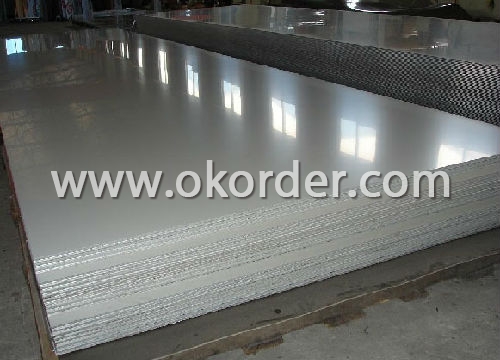
- Q:Are stainless steel strips suitable for kitchen appliances?
- Indeed, kitchen appliances can be enhanced with the use of stainless steel strips. Stainless steel, renowned for its durability, resistance to corrosion, and sleek aesthetic, is a favored material for kitchen appliances. These strips offer versatility in their applications, whether it be covering appliance fronts or serving as decorative trim. Their modern and polished appearance adds a touch of sophistication to any kitchen, while their easy-to-clean nature ensures maintenance is a breeze. Furthermore, stainless steel's resistance to stains and smudges makes it an ideal choice for appliances that endure constant use and handling. In conclusion, when it comes to improving the functionality and aesthetics of kitchen appliances, stainless steel strips prove to be an excellent option.
- Q:What are the different types of perforation for stainless steel strips?
- Stainless steel strips can be perforated in several ways, each with its own unique characteristics and advantages. Firstly, there is round perforation. This is the most commonly used type and consists of evenly spaced round holes. It allows for good airflow and drainage, making it suitable for filters, screens, and grilles. Secondly, square perforation is another popular option. It offers a higher open area percentage compared to round perforation, providing greater visibility and improved airflow. Square perforated strips are commonly used in architectural applications, decorative panels, and speaker grilles. Thirdly, slotted perforation involves elongated slots or rectangular holes. It provides excellent ventilation while maintaining a solid surface. Slotted perforated strips are often used in applications requiring privacy, such as fencing, partitions, and sunscreens. Next, there is hexagonal perforation, which features a honeycomb-like pattern of hexagonal holes. This type of perforation offers a visually appealing design while also providing good airflow and drainage. Hexagonal perforated stainless steel strips are commonly used in architectural and decorative applications. Lastly, there is decorative perforation, which involves custom patterns and designs. These patterns can be created using various shapes, such as diamonds, stars, or waves, to enhance the aesthetic value of the strip. Decorative perforated stainless steel strips are commonly used in interior design, furniture, and artistic installations. In conclusion, the choice of perforation type for stainless steel strips depends on specific application requirements such as airflow, visibility, drainage, and aesthetics. Different perforation types offer distinct benefits, allowing for versatility and customization in various industries.
- Q:Can stainless steel strips be used in the production of kitchen sinks?
- Yes, stainless steel strips can be used in the production of kitchen sinks. Stainless steel is a popular choice for kitchen sinks due to its durability, corrosion resistance, and aesthetic appeal. Stainless steel strips are commonly used in sink manufacturing to form the shape and structure of the sink, providing strength and longevity to the product.
- Q:What are the common uses of stainless steel strips in the food manufacturing process?
- Stainless steel strips are widely used in the food manufacturing process due to their unique properties and hygienic nature. Some common uses of stainless steel strips in the food manufacturing process include: 1. Conveyor Belts: Stainless steel strips are commonly used as conveyor belts in food processing plants. These strips are resistant to corrosion and can withstand high temperatures, making them suitable for transporting food items through various stages of production. 2. Food Processing Equipment: Stainless steel strips are used to construct equipment such as mixers, blenders, grinders, and slicers. The high strength and durability of stainless steel strips ensure that these equipment can withstand the rigorous demands of food processing, while also maintaining a clean and hygienic surface. 3. Food Storage and Handling: Stainless steel strips are used to construct storage containers, shelves, and racks in food manufacturing facilities. The non-reactive nature of stainless steel ensures that it does not contaminate the food products, maintaining their quality and safety. 4. Food Packaging: Stainless steel strips are used in the production of food packaging materials, such as cans, trays, and lids. These strips provide a strong and durable packaging solution, protecting the food from external contaminants and ensuring its freshness and longevity. 5. Heat Exchangers: Stainless steel strips are utilized in the construction of heat exchangers, which play a crucial role in the food manufacturing process. Heat exchangers help in heating or cooling food products, maintaining the desired temperature for processing, pasteurization, or storage. 6. Sanitary Fittings: Stainless steel strips are used to fabricate sanitary fittings like pipes, valves, and connectors. These fittings are essential for maintaining a hygienic environment in food processing facilities, as stainless steel is easy to clean, resistant to bacterial growth, and does not contaminate the food products. Overall, the common uses of stainless steel strips in the food manufacturing process revolve around their corrosion resistance, durability, cleanliness, and ability to maintain food quality and safety.
- Q:Can stainless steel strips be used in transportation applications?
- Yes, stainless steel strips can certainly be used in transportation applications. Stainless steel is known for its high strength and durability, which makes it suitable for various transportation components. It is commonly used in the automotive industry for manufacturing parts such as exhaust systems, body panels, and trim. Stainless steel strips are also used in the aerospace industry to make aircraft components, including frames, brackets, and fittings. Additionally, stainless steel's resistance to corrosion and oxidation makes it ideal for marine transportation applications, such as boat building and shipbuilding. Overall, stainless steel strips are versatile and reliable materials for transportation applications due to their strength, durability, and resistance to environmental factors.
- Q:Are stainless steel strips recyclable?
- Yes, stainless steel strips are recyclable. Stainless steel is a highly valuable and versatile material that can be recycled repeatedly without losing its properties. The recycling process involves melting down the stainless steel strips and transforming them into new products. This not only helps in conserving natural resources but also reduces the environmental impact of mining and manufacturing new stainless steel. Recycling stainless steel strips is a sustainable and responsible approach that contributes to a circular economy.
- Q:Are stainless steel strips suitable for automotive trim?
- Stainless steel strips are an excellent option for automotive trim due to their durability and resistance to corrosion. This material is perfect for exterior applications in the automotive industry, as it provides a sleek and polished look that enhances the overall aesthetic appeal of the vehicle. Furthermore, stainless steel strips can withstand harsh environmental conditions, such as extreme temperatures, moisture, and road debris, without losing their shine or structural integrity. In addition to their resilience, these strips are also easy to clean and maintain, ensuring that the trim remains in pristine condition for a long time. In summary, stainless steel strips offer outstanding durability, aesthetics, and functionality, making them the perfect choice for automotive trim.
- Q:Are stainless steel strips suitable for electrical applications?
- Yes, stainless steel strips are suitable for electrical applications. Stainless steel has excellent electrical conductivity and is resistant to corrosion, making it a reliable choice for various electrical components and systems.
- Q:Can stainless steel strips be used in the agriculture industry?
- Indeed, the agriculture industry can make use of stainless steel strips. Stainless steel is renowned for its exceptional strength, durability, and resistance to corrosion, making it an ideal option for a range of agricultural purposes. One application for stainless steel strips is in the fabrication of agricultural machinery and equipment, such as tractors, plows, and harvesters. These strips can be shaped into various components, including brackets, frames, and supports, which provide the machinery with both structural integrity and longevity. Furthermore, stainless steel strips are commonly utilized in the construction of storage tanks, silos, and containers for holding fertilizers, pesticides, and other agricultural chemicals. The corrosion resistance of stainless steel guarantees the safe storage of these substances, preventing any contamination or leakage. Moreover, stainless steel strips find use in the creation of greenhouse structures and irrigation systems. By forming the strips into hoops and supports, sturdy and long-lasting greenhouse frames can be produced. Additionally, these strips can be employed in irrigation pipes and fittings to ensure the efficient delivery of water to crops without degradation or contamination. Additionally, stainless steel strips are invaluable in the manufacture of agricultural tools and implements, such as knives, blades, and cutting edges. Thanks to stainless steel's high strength and wear resistance, these tools are durable and capable of withstanding the demanding conditions of agricultural operations. To summarize, stainless steel strips offer a host of advantages to the agriculture industry, including strength, durability, and corrosion resistance. These qualities make stainless steel a fitting choice for various agricultural applications, ultimately enhancing productivity, efficiency, and safety within the sector.
- Q:Can 111 stainless steel strips be used in geothermal power plants?
- Yes, 111 stainless steel strips can be used in geothermal power plants. Stainless steel is known for its excellent corrosion resistance, which makes it suitable for use in environments with high temperatures and corrosive conditions, such as geothermal power plants. The 111 grade stainless steel, also known as AISI 304, is a commonly used stainless steel grade that offers good strength, durability, and resistance to oxidation. It can withstand the high temperatures and harsh conditions present in geothermal power plants, making it a suitable choice for various applications, including pipe and tube fittings, heat exchangers, and other components in the geothermal power generation system.
1. Manufacturer Overview |
|
|---|---|
| Location | Changsha,China |
| Year Established | 2003 |
| Annual Output Value | Above US$36 billion |
| Main Markets | Mid East;Western Europe;North America |
| Company Certifications | ISO 9001:2008; |
2. Manufacturer Certificates |
|
|---|---|
| a) Certification Name | |
| Range | |
| Reference | |
| Validity Period | |
3. Manufacturer Capability |
|
|---|---|
| a)Trade Capacity | |
| Nearest Port | Changsha |
| Export Percentage | 0.8 |
| No.of Employees in Trade Department | 160,000 People |
| Language Spoken: | English;Chinese;Japanese |
| b)Factory Information | |
| Factory Size: | Above 3,000,000 square meters |
| No. of Production Lines | Above 10 |
| Contract Manufacturing | OEM Service Offered;Design Service Offered |
| Product Price Range | Average |
Send your message to us
304 2B Stainless Steel Sheet
- Loading Port:
- China Main Port
- Payment Terms:
- TT or LC
- Min Order Qty:
- 1 Ton m.t.
- Supply Capability:
- 5000 Tons Per Month m.t./month
OKorder Service Pledge
OKorder Financial Service
Similar products
New products
Hot products
Hot Searches
Related keywords
